
Alicante to Guadalest Day Trip: What to See & Why It’s Worth It
Planning a day trip from Alicante to Guadalest? Here’s everything you need to know.
From how to get there and the best things to do, to why visitors fall in love with this picturesque village in the mountains.
Why Visit Guadalest from Alicante?
If you’ve never heard of Guadalest before, get ready to fall in love. This small mountain village is one of the most enchanting hidden gems in Spain — and it’s just an hour away from Alicante. In this guide, you’ll discover why it’s worth the trip: how to get there, the best things to see, where to eat, and how to make the most of your visit. Whether you’re traveling by car, bus, or joining a guided tour, here you’ll find everything you need to plan the perfect day in Guadalest.
Is Guadalest Worth Visiting? Absolutely — Here’s Why dame
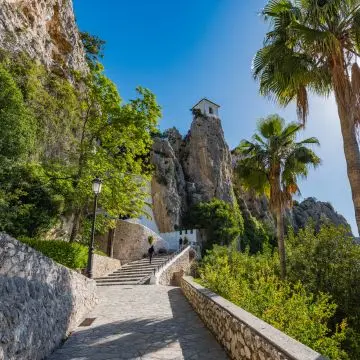
Tucked away in the mountains of the Costa Blanca, Guadalest is a village that feels frozen in time — a hidden treasure where history, culture, and Spanish tradition come together. Once an ancient Moorish stronghold, today it stands as one of Spain’s most beautiful and best-preserved hilltop villages. This day trip from Alicante to Guadalest takes you through winding mountain roads to a place filled with cobbled streets, whitewashed houses, and viewpoints that open to breathtaking scenes of the blue reservoir below.
Inside its stone gates, you’ll find a medieval castle, quirky museums, and artisanal shops where locals still sell handmade crafts and regional delicacies. Visitors love wandering through its quiet alleys, enjoying tapas with a view, or simply pausing to take in the serenity that contrasts so beautifully with the lively coast of Alicante.
Whether you’re looking for things to do near Alicante, exploring authentic Spanish villages, or searching for a peaceful escape into the mountains, visiting Guadalest is an experience that captures the essence of the Costa Blanca — timeless, scenic, and unforgettable.
Your Perfect Guadalest Experience with Toro Tours
Discover Guadalest with ease through our small-group tours. Choose between a relaxed Town Tour with Free Time or the Guadalest & Winery Tour, both including local guides, scenic views, and return-to-ship guarantee.

Come and Discover Guadalest with us!
How to Get to Guadalest from Alicante
Reaching Guadalest from Alicante is easy and rewarding — the journey itself is part of the experience. The route winds through charming mountain landscapes, small villages, and olive groves before revealing one of the most stunning viewpoints on the Costa Blanca.
See the Route on the Map
By Car – Freedom and Flexibility
riving to Guadalest gives you the freedom to explore at your own pace. The distance is about 60 km, and the trip takes around one hour along the scenic CV-70 road, passing through Polop and Callosa d’en Sarrià. There’s a large parking area just outside the village entrance.
💡Toro Local tip: Start early in the morning to enjoy the village before most tour groups arrive, and combine your visit with a stop at the Algar Waterfalls nearby.
By Bus – Budget-Friendly but Limited
There’s no direct bus from Alicante to Guadalest, but you can get there easily with a short transfer in Benidorm.
First, take an ALSA bus from Alicante to Benidorm (about 50 minutes), then continue on the Llorente Bus Line L13 to Guadalest (around 45 minutes).
The route passes through charming mountain towns like La Nucía and Callosa d’en Sarrià before reaching Guadalest. It’s a low-cost and scenic option, though schedules are limited — especially outside summer.
For travelers on a tight schedule or cruise visitors, joining a guided tour from Alicante with Toro Tours ensures a smooth, worry-free day with guaranteed return on time.
With a Guided Tour (Recommended)
The most comfortable option — especially if you prefer not to drive or plan everything — is a guided day trip from Alicante.
With Toro Tours, you’ll enjoy:
- Pickup from your hotel or the cruise port.
- A local English-speaking guide.
- Guaranteed return on time to your ship or accommodation.
- Optional winery visit or free time for lunch with a view.
Make the most of your day — sit back, relax, and let us handle the details.
Discover our Guadalest Tours
Top Things to Do in Guadalest
Even though Guadalest is small, every corner hides a story. Walking through its narrow streets feels like stepping into a living postcard — where every stone, every view, and every silence invites you to slow down and take it all in. Every traveler finds something different here — a moment of beauty, a story from the past, or simply the calm of a place untouched by time.
Beyond its peaceful charm, there’s plenty to experience: climb to the ancient castle, visit its curious museums, taste local flavors, and enjoy some of the most breathtaking views on the Costa Blanca. Here are the top things to do in Guadalest that make this village a must-see on your trip from Alicante.
Visit the Castle of San José
At the heart of the village stands the ancient Castle of San José (also known as the Castle of Guadalest), a medieval fortress perched dramatically above the valley. Climb its old stone steps through the arched gateway, and as you reach the top, the world opens up before you — rolling hills, olive trees, and the turquoise reservoir glimmering below. The view alone makes the climb unforgettable, especially on a clear day when the mountains fade into the horizon.
Inside the castle walls, history comes alive. Built by the Moors in the 11th century and later expanded by the Christians, the fortress served as a lookout and defensive stronghold over the valley. Today, visitors can wander through the ruins of ancient towers, see parts of the old cistern, and visit the bell tower of the Virgen de la Asunción, which has become the most iconic image of Guadalest.
From the top, you’ll also spot the small museum and archaeological remains that tell the story of how the town survived wars, earthquakes, and sieges through the centuries. Every viewpoint offers a different perspective of the valley and the glittering blue reservoir below — a photographer’s dream.
💡 Did you know?
Guadalest actually has two castles. The one you can visit today is the Castle of San José (Castle of Guadalest), reached through the Casa Orduña Museum. Across the valley stand the ruins of the Alcozaiba Castle, an older Moorish tower that once guarded the village from above.
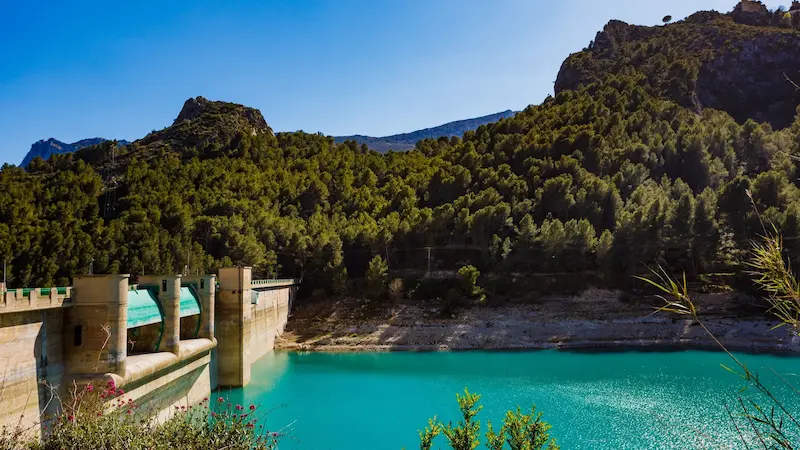
💡Toro Local tip
- Bring a bottle of water and your camera — the viewpoints are spectacular.
- Wear comfortable shoes, as the steps are steep and uneven in some areas.
- Visit in the morning or late afternoon for the best light and fewer crowds.
- The Casa Orduña Museum next to the entrance is worth a visit to see how noble families lived during the 17th century.

Come and Discover Guadalest with us!
Microgiant Museum
Tucked away inside one of Guadalest’s whitewashed houses, this museum is one of those places you’d almost walk past — and yet it holds one of the most mind-blowing collections in Spain. The Museum of Micro Miniatures is a tribute to patience, precision, and imagination taken to impossible scales.
Step inside, and you’ll enter a world where an ant plays the violin, a bullfight fits inside the head of a pin, and a portrait of Goya is painted on a grain of rice. Every piece was created by Spanish artist Manuel Ussà, who dedicated his life to mastering the art of the invisible. A magnifying glass accompanies you as you move from display to display — revealing details you’d never believe the human hand could achieve.
The space itself is intimate, with dim lighting and carefully designed showcases that make the experience feel almost magical. No matter who you visit with, you’ll leave with a sense of wonder — proof that the tiniest creations can awaken the biggest emotions.
💡 Did You Know?
There’s another museum in Guadalest created by the same artist, Manuel Ussà — the Museum of Micro Miniatures.
While the Museo Microgigante mixes tiny artworks with giant sculptures, the Micro Miniatures Museum focuses entirely on microscopic creations so small they can only be seen through a magnifying glass.
Both are located in the village center and can be visited with a combined ticket available at either entrance. If you want more information you can visit their website here.
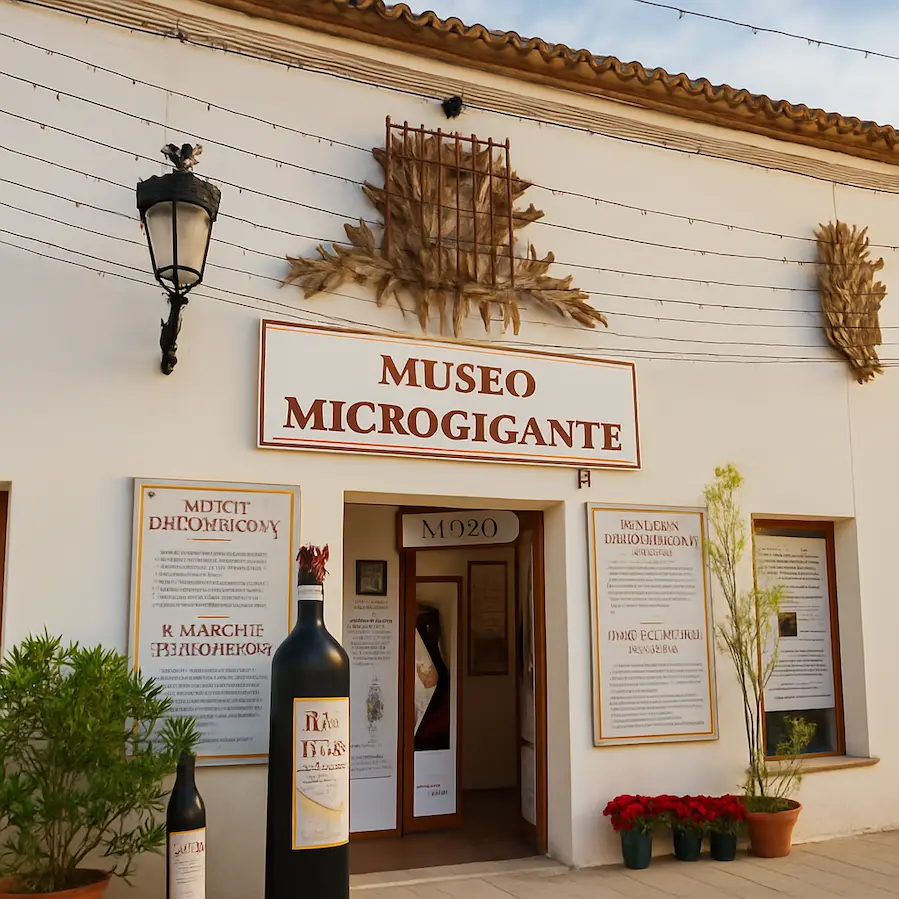
Enjoy the Best Viewpoints in Guadalest
One of the most unforgettable parts of any day trip from Alicante to Guadalest is standing before its views — that moment when the turquoise water, rugged cliffs, and whitewashed houses all meet in perfect harmony.
Guadalest may be small, but its surroundings offer some of the most breathtaking viewpoints on the Costa Blanca.
Mirador de la Muralla – The Heart of the Village
Tucked inside the old town walls, this viewpoint feels like a balcony over time. From here, the Guadalest reservoir shimmers below, framed by pine-covered hills and the stone houses clinging to the cliffs.
In the late afternoon, the sun paints everything golden — the light, the silence, and the sense of peace make this spot unforgettable. It’s where most travelers stop for their last photo before leaving the village.
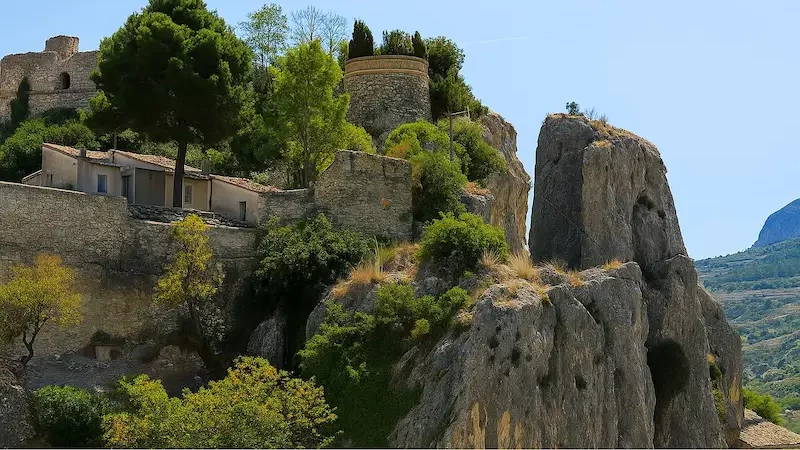
Mirador del Valle de Guadalest – The Postcard View
Before reaching the historic center, stop at the roadside Mirador del Valle de Guadalest. From this open platform, the view stretches across the valley — the Castle of San José perched high on its rock, the reservoir shining deep blue, and the distant peaks fading into the horizon.
It’s the kind of view that makes you pause without realizing it. Bring your camera — this is where you’ll capture that perfect panoramic shot of Guadalest Valley.
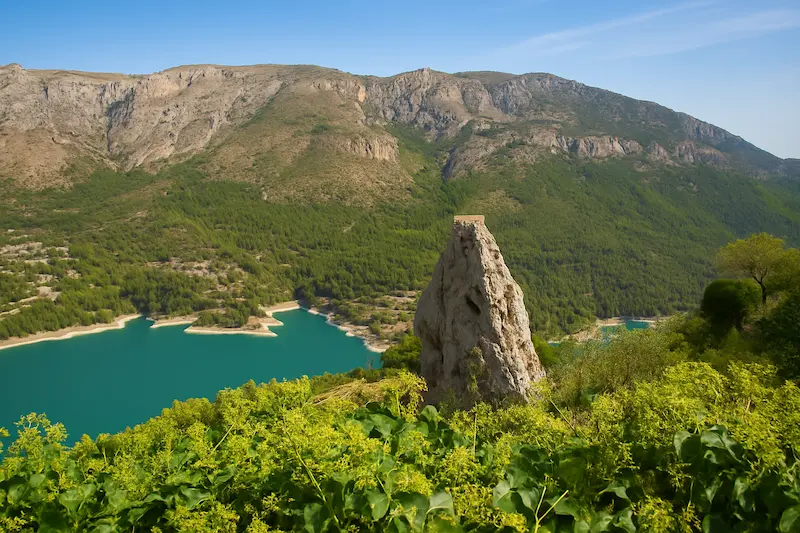
Torre de la Penya d’Alcalà – The Icon Above the Valley
Look up from anywhere in Guadalest and you’ll see it — a small white tower standing proudly on a rocky peak. That’s the Torre de la Penya d’Alcalà, a centuries-old Moorish watchtower that once guarded the valley.
Today it’s one of the village’s most recognizable landmarks. A short, scenic walk leads you up to its base, where you’ll enjoy a 360º view of the castle, the reservoir, and the mountains of Alicante’s interior. Standing there, with the wind and silence around you, you understand why this valley feels like something out of a storybook.
💡 Local Tip: Start your visit at the Valley Viewpoint, climb to the Torre de la Penya d’Alcalà, and end your day at the Mirador de la Muralla to watch the light fade over the mountains — the perfect way to see Guadalest from every angle.
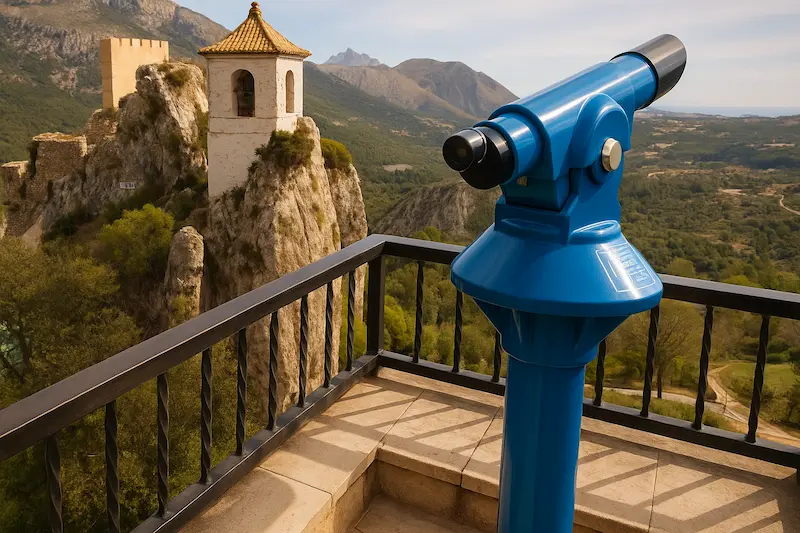
Taste Local Wines and Mountain Honey
After exploring the viewpoints and cobbled streets, take a moment to experience Guadalest through its flavors. Around the village, tiny shops and family cafés invite you to slow down and discover the valley’s best-kept secrets — its local wine, mountain honey, and handmade cheeses.
The wines come from nearby vineyards nestled in the Alto Vinalopó region, where the dry climate and limestone soil give each bottle a distinct Mediterranean character. You’ll find smooth reds and fresh whites, often served by the producers themselves, proud to share their work.
Equally special is the mountain honey, made by local beekeepers who place their hives among rosemary, thyme, and orange blossoms. A single spoonful reveals the taste of the hills — pure, floral, and timeless. Many shops also sell small jars of honey, olive oil, and almond sweets, perfect to take home as a memory of this mountain village.
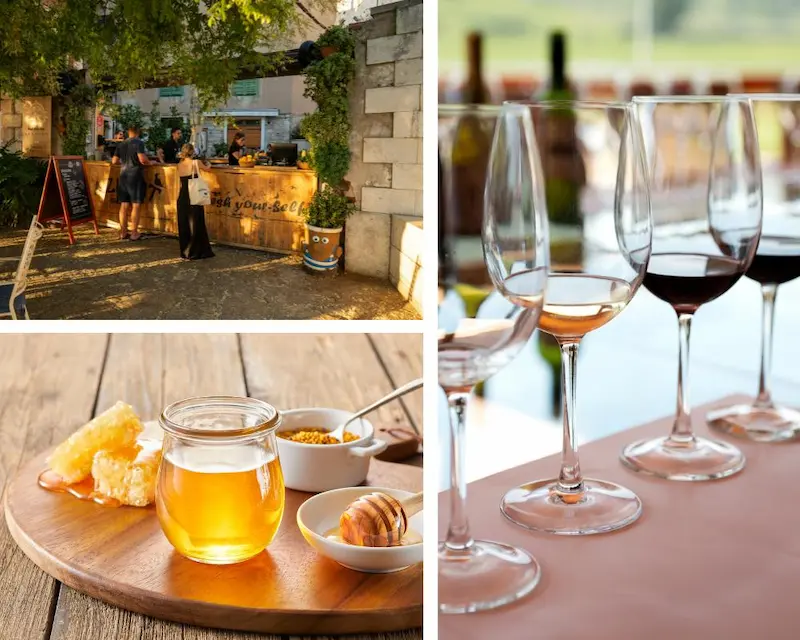
💡 Toro Local Tip:
If you join our Guadalest & Winery Tour, you’ll visit a traditional bodega for a guided tasting and learn how local wines and honey are still produced today — a true taste of the Costa Blanca countryside.
Enjoy Spanish Tapas with a View
Few places make lunch feel as special as Guadalest. Here, eating is part of the experience — a way to slow down and take in the view while savoring the region’s Mediterranean flavors.
Several small restaurants and terraces sit right on the edge of the cliffs, offering panoramic views of the Guadalest Valley and the turquoise reservoir below.
Try El Tossal, known for its local tapas and mountain-style dishes like gazpacho manchego and grilled lamb. The Restaurante Mora is another favorite, with a shaded terrace overlooking the reservoir — perfect for a glass of local wine and a plate of jamón ibérico or fried aubergines with honey.
If you prefer something light and scenic, El Castell offers Spanish tapas with one of the best views in town. And for coffee or dessert, stop by Café Gastrobar El Riu, where you can relax with homemade cakes and a stunning mountain backdrop.
💡 Toro Local Tip:
Book a table for late lunch (around 2:30 p.m.) — the light over the valley is magical at that hour, and the crowds are gone.
Shop for Crafts and Souvenirs
Wandering through Guadalest’s narrow streets is also a great excuse to explore its artisan shops and small family boutiques. The village is full of places selling handmade pottery, ceramics, olive oil, almond sweets, wooden toys, and local honey — all perfect reminders of your visit.
Along Calle del Sol and Calle Virgen, you’ll find several traditional shops where artisans still create and sell their own pieces. Don’t miss Artesanía Guadalest, famous for its ceramic souvenirs and painted tiles, or Productos del Valle, where you can taste and buy honey, olive oil, and almond nougat made in nearby villages.
For something truly unique, visit Museo de Miniaturas Gift Shop — it offers tiny handmade replicas and curiosities inspired by the local museums, ideal as collector’s items.
💡 Toro Local Tip:
If you’re visiting in summer, go early in the morning or near sunset — most shops close for siesta around 2:00 p.m. and reopen in the late afternoon.
Why We Recommend Visiting Guadalest
There are places that don’t just appear on your itinerary — they stay with you. Guadalest is one of them.
It’s not only about the castle or the views, but the feeling you get while wandering its quiet streets, hearing church bells echo across the valley, or tasting honey made just a few hills away.
We’ve guided hundreds of travelers here, and every single one has left with the same look — that quiet smile that comes after discovering something real.
If you’re in Alicante, don’t miss it. Guadalest isn’t just a stop — it’s the kind of place that reminds you why you love to travel.
FAQs about Guadalest Day Trips
How far is Guadalest from Alicante and how long does it take?
Guadalest is about 60 km from Alicante. By car or on a guided tour it takes roughly 1 hour. By public transport (ALSA to Benidorm + Llorente Bus L13 to Guadalest) allow about 1h 45m–2h each way.
What’s the best way to get from Alicante to Guadalest?
Fastest and easiest is by car or a guided day trip (no parking stress, local insights). There is no direct bus from Alicante: you must take ALSA to Benidorm and then Llorente Bus L13 to Guadalest.
Is there a direct bus from Alicante to Guadalest?
No. Take ALSA Alicante → Benidorm (about 50 min) and connect with Llorente Bus Line L13 to Guadalest (about 40–45 min). Schedules are limited, especially outside summer.
Where does the bus connection happen in Benidorm?
Get off ALSA at the Benidorm Bus Station for the smoothest connection. L13 also serves Avenida Europa; both stops are 10–15 minutes apart on foot.
How much time do I need in Guadalest?
Plan 2–3 hours for the village: castle viewpoint, museums, stroll through the old town, and a tapas stop. With a winery visit or the Algar waterfalls, make it a half-day (4–5 hours).
Is Guadalest worth visiting?
Absolutely. It’s one of the most scenic day trips from Alicante: a hilltop village with a medieval castle, panoramic viewpoints, quirky museums, artisan shops, and great local flavors.
How much are the castle tickets and what are the hours?
Castle of San José is accessed via Casa Orduña. Typical hours: 10:00–18:00 (winter), 10:00–20:00 (summer). Tickets around €4 adults, reductions for children and groups. Hours may vary with weather/season.
What museums can I visit in Guadalest?
Two visitor favorites are the Museo Microgigante and the Museum of Micro Miniatures (both by artist Manuel Ussà). Single ticket ~€4; combined ticket for both ~€6 (adults). They’re a few steps apart in the old town.
What are the best viewpoints in Guadalest?
Don’t miss the Mirador de la Muralla (inside the old town), the roadside Mirador del Valle de Guadalest for wide panoramas, and the iconic Torre de la Penya d’Alcalà overlooking the valley.
Where can I eat or try local products?
For tapas with a view try El Tossal, Restaurante Mora or El Castell. For local products, look for shops on Calle del Sol (honey, olive oil, almond sweets, ceramics) and winery tastings on guided tours.
Is Guadalest suitable for kids and families?
Yes. The village is compact and walkable. Children love the miniature museums and viewpoints. Note there are some steep steps to reach the castle.
Is Guadalest accessible for wheelchairs or strollers?
Parts of the old town are steep and cobbled. The castle area has stairs. Some museums are accessible; check at the door. For smoother access, consider a private tour tailored to mobility needs.
What’s the best time of day or year to visit?
For softer light and fewer crowds, go in the morning or late afternoon. Spring and autumn offer mild weather; summer brings longer hours and more buses but is warmer.
Do you run guided tours from Alicante to Guadalest?
Yes — our small-group Guadalest Town Tour with Free Time and Guadalest & Winery Tour include round-trip transport from Alicante, a local guide, scenic stops, and a return-on-time guarantee for cruise guests.
Remember: Toro Tours is here to help you.
Don’t worry about a thing and just enjoy your excursions with Toro Tours.
Learn more about us here